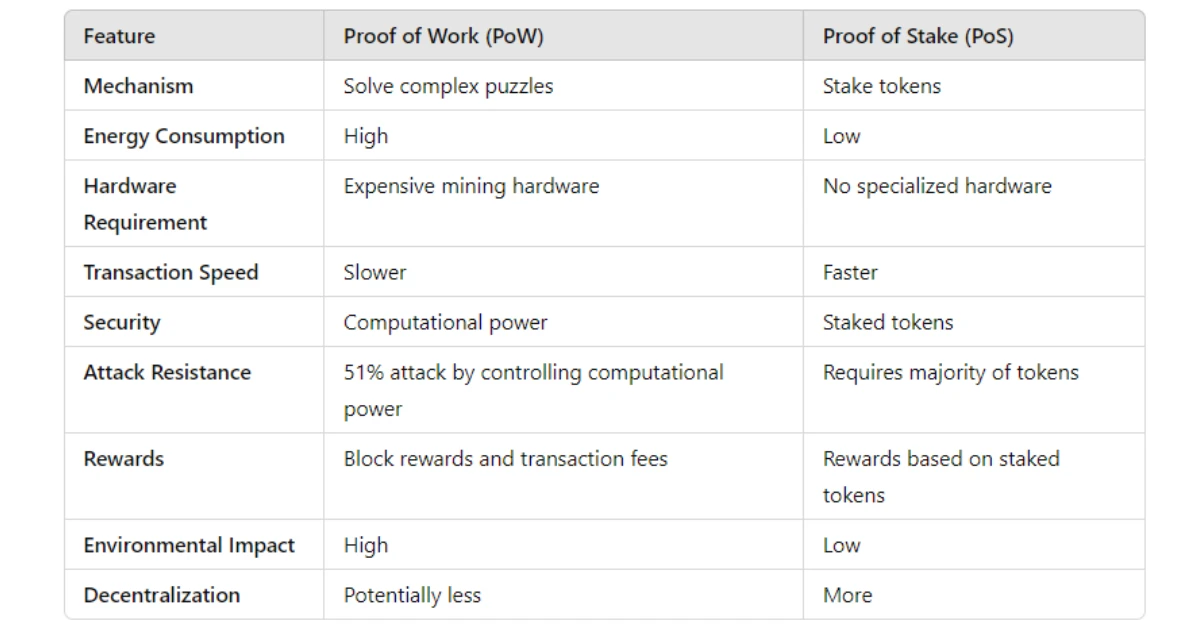What Is Proof of Stake?
Proof of Stake (PoS) is a blockchain consensus mechanism that offers a more efficient alternative to Proof of Work (PoW). Instead of relying on costly hardware and energy-intensive mining processes, PoS allows users to participate in transaction validation by staking their assets.
In a Proof of Stake mechanism, users who own more native tokens of the blockchain they participate in have a higher chance of being selected as validators. These validators earn rewards for verifying on-chain transactions. This system helps reduce environmental impact and creates a more efficient and secure consensus mechanism for confirming transactions on PoS blockchains.
The PoS mechanism minimizes cybersecurity risks, as the potential profit from attacking becomes less attractive. The next block validator is usually chosen randomly, with preference given to those holding large assets.
Key Takeaways
|
How Does Proof of Stake Work?
Proof of Stake (PoS) operates through a series of following steps:
- Stake Tokens: Users must own at least the minimum number of tokens required by the blockchain and stake these tokens into the network to become a node in the consensus process. This action ensures honesty and stakes the node’s assets in the system.
- Select Nodes: A few nodes are randomly chosen to participate in the consensus process. These nodes must meet the requirements of owning the necessary tokens and adhering to the network’s computational and security rules.
- Verify Transactions: The selected nodes verify new transactions on the network. Once the transactions are accurately verified, the nodes add them to a newly created block.
- Create New Block: After reaching a consensus on the transactions, the nodes collaboratively create a new block on the network. The tokens they staked determine the share of rewards for participating in the consensus and creating this new block.
- Update Blockchain: The newly created block is added to the blockchain and broadcasted to all nodes in the system.
- Rewards: Nodes receive rewards proportional to the number of tokens they staked for participating in the consensus and creating the new block.
Proof of Stake vs. Proof of Work
The mechanisms and characteristics of Proof of Work (PoW) and Proof of Stake (PoS) differ significantly. In PoW, creating new blocks requires miners to solve complex mathematical problems, consuming a lot of energy. In contrast, PoS allows validators to stake tokens to verify transactions and create new blocks without requiring much energy.
PoS generally offers faster processing speeds and lower risks in ensuring system security, as network attacks would require a large number of tokens. This improves the decentralization of consensus because nodes need to stake a certain amount of tokens to participate, keeping the system more distributed.
In simple terms, PoS is a faster and potentially more secure alternative for blockchain networks.

Benefits of Proof of Stake
Proof of Stake (PoS) offers several advantages over other consensus mechanisms:
- Accessible Node Setup: PoS doesn’t require high-end hardware; anyone can set up specialized nodes on their computer or server.
- Delegation Option: Users can sometimes delegate their stake to Validators, giving them additional voting power. In return, the delegator receives rewards without much effort.
- Scalability and Transaction Speed: PoS enhances scalability and transaction speed, improving decentralization as validation can be performed by anyone staking tokens in the network, creating a decentralized network.
- Environmental Friendliness: PoS is more environmentally friendly as it doesn’t require high electricity consumption like Proof of Work (e.g., Bitcoin).
Challenges of Proof of Stake
While Proof of Stake (PoS) offers many benefits, there are also some challenges and concerns associated with this consensus mechanism:
- Risk of Capital Lockup: When delegating or becoming a Validator, users receive additional coins but risk having their capital locked up or even losing value due to coin depreciation. Sometimes, the compensation received may not be enough to cover the initial investment.
- Unlocking Periods: There may be cases where tokens are locked for a certain period, such as one or two weeks. This can leave users unable to react quickly to price fluctuations.
- Centralization Tendencies: Token locking is related to governance, so those who lock more tokens have more influence. This can lead to centralization, where a few individuals have excessive power, dictating project decisions, even if they may not benefit the project as a whole.
- Security Concerns: Anyone can become a Validator by owning many tokens, increasing the risk of a 51% attack and potential abuse of power by Validators.
- Complex System Setup: Setting up a PoS system requires significant coordination among all parties involved. This complexity can lead to delays in system implementation and operation.
Popular Proof of Stake Cryptocurrencies
Most blockchains developed after Ethereum employ the Proof of Stake (PoS) consensus mechanism. Typically, each blockchain is tailored to meet the network’s specific needs. Ethereum itself is undergoing a transition to PoS with Ethereum 2.0.
Blockchains utilizing PoS or its variants include:
- BNB Chain
- BNB Smart Chain
- Solana
- Avalanche
- Polkadot
The Bottom Line
In conclusion, CoinMinutes has delved into understanding the Proof of Stake consensus mechanism with you. We hope that through this article, you have gained a better understanding of the term Proof of Stake as well as collected valuable information.








